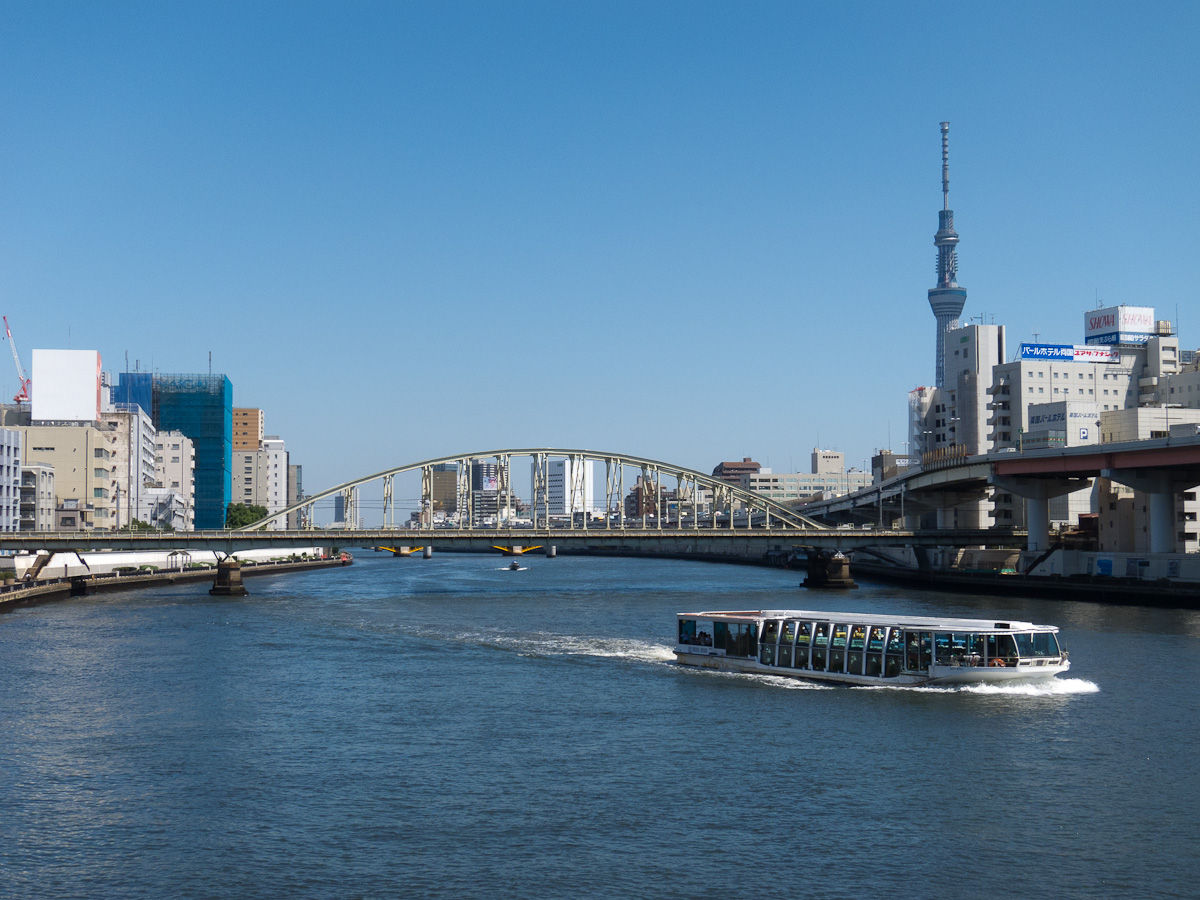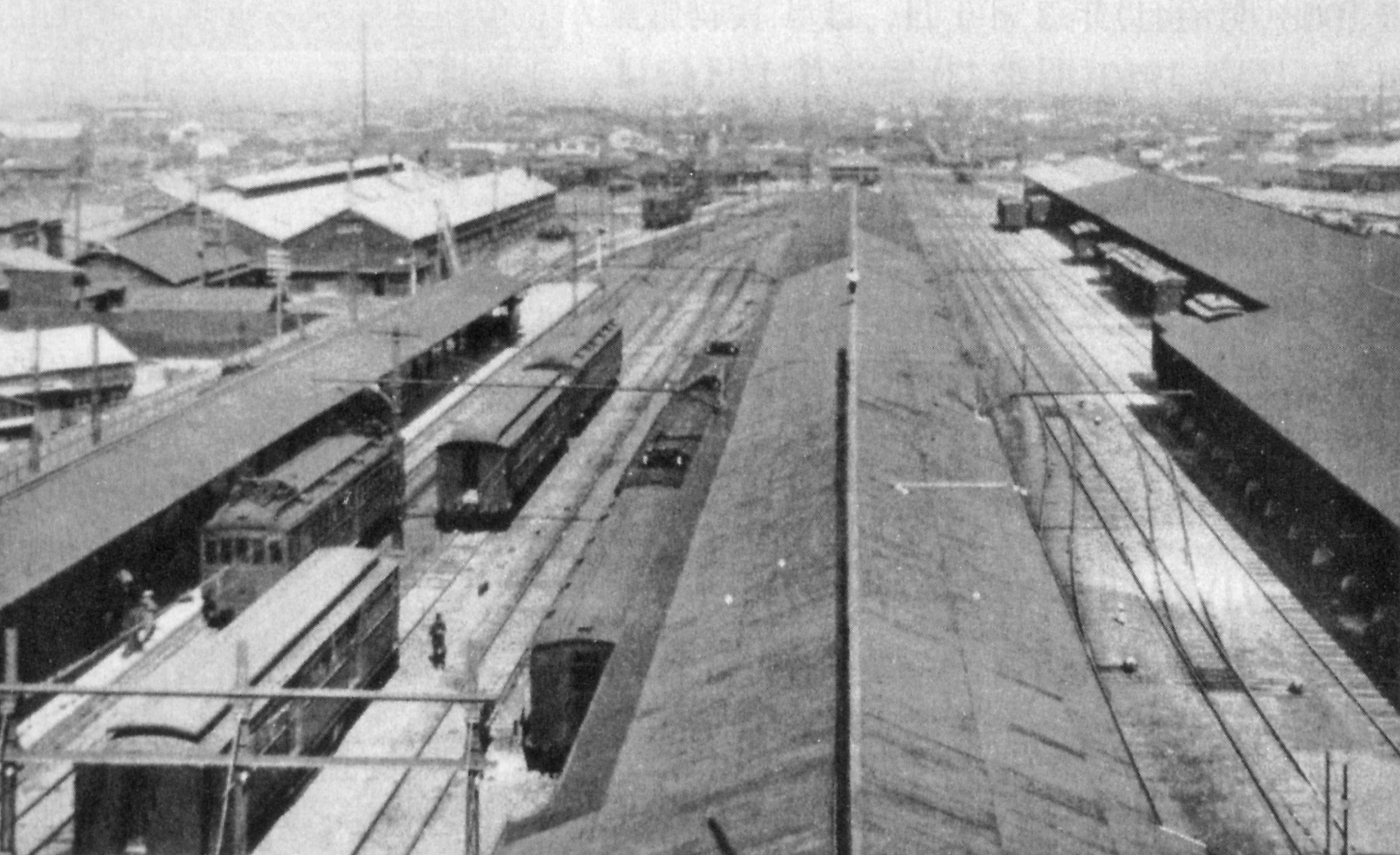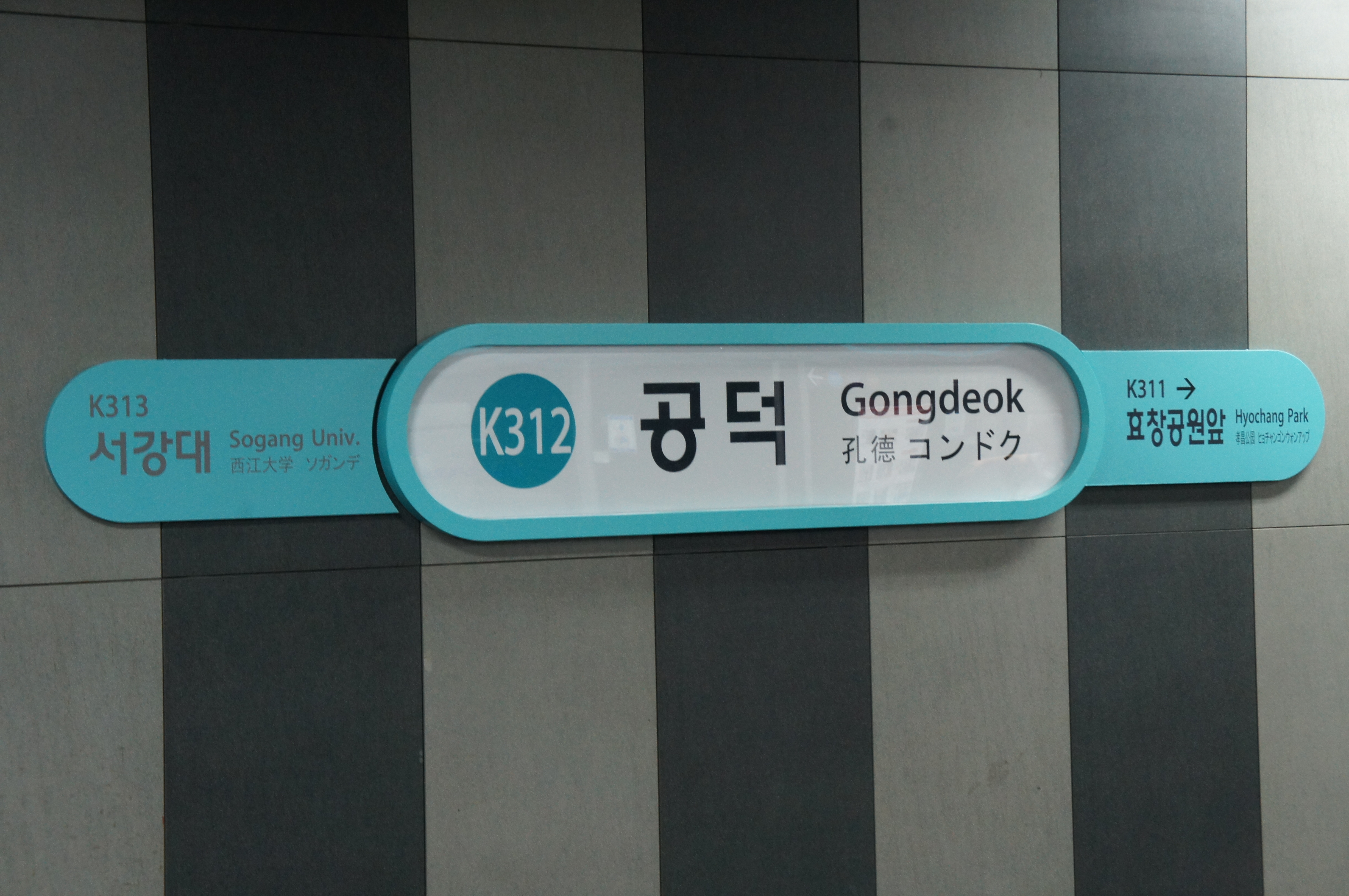|
Oshiage Station
is a railway station in Sumida, Tokyo, Japan, jointly operated by Tokyo Metro, Tobu Railway, Tokyo Metropolitan Bureau of Transportation, Toei, and Keisei Electric Railway. It is adjacent to the Tokyo Skytree complex. Lines Oshiage Station is served by the following lines. It is the terminal station of three lines. * Keisei Oshiage Line (station number KS45) – through service to the Toei Asakusa Line * Tobu Skytree Line (station number TS-03) – through service to the Tokyo Metro Hanzomon Line *Toei Asakusa Line (station number A-20) – through service to the Keisei Oshiage Line * Tokyo Metro Hanzōmon Line (station number Z-14) – through service to the Tobu Skytree Line Station layout There are two sets of platforms, one for Keisei/Toei at level B1, and the other for Tokyo Metro/Tobu at level B3. Each consists of two island platforms serving four tracks. Keisei/Toei On the Keisei/Toei section, trains to Nishi-Magome and the Keikyu Network leave from platforms 1, 2 ... [...More Info...] [...Related Items...] OR: [Wikipedia] [Google] [Baidu] |
Sumida, Tokyo
is a Special wards of Tokyo, special ward in the Tokyo, Tokyo Metropolis in Japan. The English translation of its Japanese self-designation is Sumida City. As of 1 April 2025, the ward has an estimated population of 287,766 and a population density of 20,120 persons per km2. Its total area is 13.77 km2. Sumida's city office is located in Azumabashi, while its commercial center is the area around Kinshicho Station in the south. Geography Sumida is in the north-eastern part of the mainland portion of Tokyo. The Sumida and Arakawa are the major rivers, and form parts of its boundaries. Its neighbors are all special wards: Adachi, Tokyo, Adachi to the north; Arakawa, Tokyo, Arakawa to the northwest; Katsushika, Tokyo, Katsushika to the east; Edogawa, Tokyo, Edogawa to the southeast; Taitō, Tokyo, Taitō to the west; Chūō, Tokyo, Chūō to the southwest; and Kōtō, Tokyo, Kōtō to the south. Landmarks *Asahi Breweries headquarters: The Asahi Beer Hall, with the ''Asahi fl ... [...More Info...] [...Related Items...] OR: [Wikipedia] [Google] [Baidu] |
Island Platform
An island platform (also center platform (American English) or centre platform (British English)) is a station layout arrangement where a single platform is positioned between two tracks within a railway station, tram stop or transitway interchange. Island platforms are sometimes used between the opposite-direction tracks on twin-track route stations as they are cheaper and occupy less area than other arrangements. They are also useful within larger stations, where local and express services for the same direction of travel can be accessed from opposite sides of the same platform instead of side platforms on either side of the tracks, simplifying and speeding transfers between the two tracks. The historical use of island platforms depends greatly upon the location. In the United Kingdom the use of island platforms on twin-track routes is relatively common when the railway line is in a cutting or raised on an embankment, as this makes it easier to provide access to the platf ... [...More Info...] [...Related Items...] OR: [Wikipedia] [Google] [Baidu] |
Railway Stations In Japan Opened In 1912
Rail transport (also known as train transport) is a means of transport using wheeled vehicles running in tracks, which usually consist of two parallel steel rails. Rail transport is one of the two primary means of land transport, next to road transport. It is used for about 8% of passenger and freight transport globally, thanks to its energy efficiency and potentially high speed.Rolling stock on rails generally encounters lower frictional resistance than rubber-tyred road vehicles, allowing rail cars to be coupled into longer trains. Power is usually provided by diesel or electric locomotives. While railway transport is capital-intensive and less flexible than road transport, it can carry heavy loads of passengers and cargo with greater energy efficiency and safety. Precursors of railways driven by human or animal power have existed since antiquity, but modern rail transport began with the invention of the steam locomotive in the United Kingdom at the beginning of the 19th c ... [...More Info...] [...Related Items...] OR: [Wikipedia] [Google] [Baidu] |
Tokyo Skytree Station
is a railway station on the Tobu Skytree Line in Sumida, Tokyo, Japan, operated by the private railway operator Tobu Railway. It is adjacent to the Tokyo Skytree and Skytree Town redevelopment, and was formerly known as Narihirabashi Station. Lines Tokyo Skytree Station is served by the Tobu Skytree Line from , and is 1.1 km from the line's Asakusa terminus. Station layout The station consists of one island platform serving two tracks. Platforms File:東武鉄道 とうきょうスカイツリー駅.JPG, Platform 2 looking east, May 2012 File:東武鉄道 とうきょうスカイツリー駅 入出口.jpg, The station entrance in May 2012 Adjacent stations All kinds of the limited express excluding ''Skytree Liner'' and ''Urban Park Liner'' stop at Hikifune Station as the next or previous station at only the morning and evening. At the noon, all of the limited express except ''Skytree Liner'' and ''Urban Park Liner'' stop at Kita-Senju Station as the next or prev ... [...More Info...] [...Related Items...] OR: [Wikipedia] [Google] [Baidu] |
Station Numbering
Station numbering is a sign system which assigns station codes consisting of a few letters and numbers to train stations. It aims to facilitate navigation for foreign travelers not familiar with the local language by using globally understood characters ( Latin letters and Arabic numbers). The system is now in use by various railway companies around the world such as in mainland China, Indonesia, Japan, South Korea, Singapore, Taiwan, Thailand, and the United States. History Station numbering was first introduced—but to less fanfare—in South Korea, by the Seoul Metropolitan Subway in 1983 as a section of Seoul Subway Line 2 ( Euljiro 1-ga to Seongsu) was opened. Its first usage in Japan was in the Nagasaki Electric Tramway where it was introduced in May 1984."History of Nagasaki Electric Tramway line transition", ''Stadtbahn'' issue 9, April 1984 The Tokyo subway system introduced station numbering in 2004. Sports events are usually the turning point for the introduct ... [...More Info...] [...Related Items...] OR: [Wikipedia] [Google] [Baidu] |
Tōbu Nikkō Line
The is a railway line in Japan operated by the private railway company Tobu Railway. It branches from Tōbu Dōbutsu Kōen Station in Miyashiro, Saitama on the Skytree Line, extending north to Tōbu Nikkō Station in Nikkō, Tochigi. The line has two branch lines: the Utsunomiya Line at Shin-Tochigi Station in Tochigi, Tochigi, and the Kinugawa Line at Shimo-Imaichi Station in Nikkō. Service patterns , stops and service patterns are * : Stops at all stations on the Nikko Line. Through to/from Naka-Meguro on the Tokyo Metro Hibiya Line; * : Stops at all stations on the Nikko Line, limited-stop service on the Skytree Line; * : Stops at all stations on the Nikko Line, limited-stop service on the Skytree Line. Through to/from Chūō-Rinkan on the Tokyu Den-en-toshi Line via the Tokyo Metro Hanzomon Line; * : Stops at all stations on the Nikko Line, limited-stop service on the Skytree Line; * : Stops at all stations on the Nikko Line, express service on the Skytree ... [...More Info...] [...Related Items...] OR: [Wikipedia] [Google] [Baidu] |
Tobu Isesaki Line
The is a Japanese railway line operated by the private railway company Tobu Railway, extending from Tōbu-Dōbutsu-Kōen Station in Saitama to Isesaki Station in Gunma Prefecture. The Isesaki Line can refer to the entire section between Asakusa - Isesaki and Oshiage - Hikifune, but from March 2012, the section south of Tōbu-Dōbutsu-Kōen was branded as the Tobu Skytree Line in conjunction with the opening of the Tokyo Skytree tower. Descriptions ;Track: :single: − :double: the rest Operation Service patterns Stops and operated sections are as of 2023, February 15. ; (announced as or for short) :*Tōbu-Dōbutsu-Kōen − Ōta. Connection with Express. Three per hour, with one between Kuki and Tatebayashi. :*Ōta − Isesaki. One per hour per direction, conductorless. ; :Between Asakusa and Tōbu-Dōbutsu Kōen, Kuki or Minami-Kurihashi on Nikkō Line. ; :Early morning and late night. Down to Tōbu-Dōbutsu-Kōen, Kuki or to Minami-Kurihashi on the Nikkō Line ... [...More Info...] [...Related Items...] OR: [Wikipedia] [Google] [Baidu] |
Shibayama Railway
The is a third-sector railway company in Chiba Prefecture, Japan. It operates Japan's shortest narrow-gauge railway line, the Shibayama Railway Line between Higashi-Narita Station and Shibayama-Chiyoda Station, largely underneath Narita International Airport. The railway company was founded on May 1, 1981, and the construction of the line began in 1998. Although issues with land acquirement forced the line to be extended by 0.2 km (220 yards) in 2000, the line opened on October 27, 2002. Although the Shibayama Railway Company is an independent operator, the line functionally resembles an extension of the Keisei Higashi-Narita Line. All services continue through the mentioned line to stations such as the Keisei Narita Station. Narita International Airport Corporation owns the majority stake in Shibayama Railway as of March 2019. The remainder is owned by others such as the Keisei Electric Railway. History Shibayama Railway was founded on May 1, 1981, and received an ope ... [...More Info...] [...Related Items...] OR: [Wikipedia] [Google] [Baidu] |
Narita Sky Access Line
The is a Japanese railway line connecting Keisei-Takasago Station and Narita Airport Terminal 1 Station. The entire route from Keisei Ueno Station, including the Keisei Main Line as far as Keisei-Takasago, is branded . The Keisei Electric Railway operates over the entire line, while other companies operate over certain sections of it, such as Hokuso Railway. The new line is used by '' Skyliner'' limited express services operating at up to using Keisei AE series EMUs. Operations Trains utilize the Keisei Electric Railway's Main Line between Keisei Ueno and Keisei-Takasago. Trains run at a maximum speed of , thus completing the run from Nippori to Narita Airport Terminal 2·3 in a minimum of 36 minutes (15 minutes faster than the previous Skyliner route, which took 51 minutes). The reserved-seat Keisei Skyliner limited express fare for the route between Narita airport and either Nippori or Ueno stations is ¥2,580 and takes 36–41 minutes, while the Access Express comm ... [...More Info...] [...Related Items...] OR: [Wikipedia] [Google] [Baidu] |
Hokusō Line
The is a commuter rail line operated by the third-sector Hokusō Railway (controlled by the Keisei Electric Railway) in Japan. It runs between Keisei-Takasago Station in Katsushika, Tokyo and Imba Nihon-idai Station in Inzai, Chiba. It is part of the primary Keisei route between central Tokyo and Narita International Airport through the Narita Sky Access Line. It uses the ATS Type 1 system. The line's name is derived from its route through the former Shimōsa Province, which is also known as "Hokusō". Operations Most trains are all-station "Local" services, but some limited-stop "Rapid" express trains have operated in morning and evening hours. ; (L) : Stops at all stations, all day. Through to Keisei Main Line, Keisei Oshiage Line, Toei Asakusa Line, Keikyū Main Line, Keikyū Airport Line and Keikyū Kurihama Line. ; : Runs only on weekdays. ; : Runs on weekday mornings only. This service is bound to Ueno Station. :Fare (adult/500 yen, child/250 yen) :Stop at f ... [...More Info...] [...Related Items...] OR: [Wikipedia] [Google] [Baidu] |






